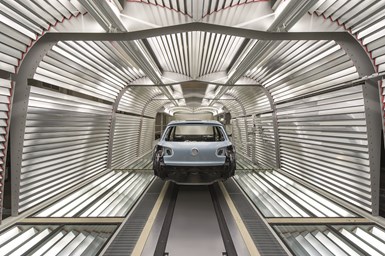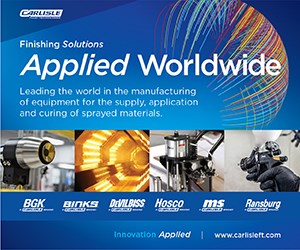
Wenker’s Ergo-Lux lighting utilizes a state-of-the-art LED light source and a system of reflectors to provide optimal luminosity and contrast for surface inspection.
Photo Credit: All photos courtesy of Wenker Inc.
What’s a final finish without a thorough surface inspection? Visual inspection and quality control can be one of the most demanding — and arguably one of the most important — tasks on the production line. A critical variable for a quality inspection is the appropriate lighting — something that can be harder than you might think to achieve. With conventional lighting systems, the light tends to reflect off the surfaces that are being evaluated. This direct light can cause a glare that can interfere with the visual inspection tasks.
This is an all-too-common challenge for surface inspectors, and the problem led Wenker Inc. (Ahaus, Germany; Charlotte, N.C.) to the development of its Ergo-Lux lighting system. Founded in 1961 in Leverkusen, Germany, Wenker got its start as a manufacturer of air ducts and ventilation system components. In 2002, the company expanded to create machine housings, panel systems and booths for the automotive industry. From there, the company has grown to specialize in design and engineering of a range of turn-key and retrofit solutions for paint booths and coatings applications. While automotive work continues to be a large part of Wenker’s core business, its panel solutions are also used in architectural work and the shipping industry. That ability to apply its expertise in one sector to additional applications has allowed Wenker to continually diversify its offerings.
Initially developed with the inspection of automotive finishes in mind, the company’s Ergo-Lux lighting systems use state-of-the-art LED lighting and an array of reflective panels to provide a method of illuminating surfaces with indirect light, effectively reducing — almost to the point of eliminating — the glare that direct light sources can produce.
“The idea of the Ergo-Lux system was the problem that we have to create uniform light conditions,” says Andreas Weßling, research and development. “It also has an advantage of ergonomics — not just for a safer and improved environment, but also for improving [the worker’s] capacity for finding the defects on the surface.”

Wenker’s Ergo-Lux light tunnel has been adopted by numerous automotive OEMs.
The Ergo-Lux tunnel was developed for the automotive sector as an efficient, ergonomic solution for performing quality control — providing improved lighting and contrast as well as comfort and accessibility for technicians. Even with the increased concentration of light, Ergo-Lux minimizes shadows in the lighting area. The technology is so powerful it is also used by inspectors to evaluate leather surfaces for mosquito bites and other minuscule irregularities.
“It’s easier and more comfortable to find defects on the paint surface of the car, improving quality, consistency and reducing rework required,” says Juliano Volpatto, Wenker head of after sales for U.S and Canada.
The light tunnel system has been incorporated into production lines by such automakers as Tesla, Audi, Porsche and Volkswagen.
Inspection with less glare
Weßling explains that in conventional lighting systems, direct light sources reflect off the surfaces, producing a glare. Ergo-Lux systems use a double light deflection effect with lengthwise reflectors that generate indirect light, producing contours of light and dark bands that enable inspectors to detect irregularities more easily. These bands of light provide optimal contrast uniformly across the entire surface. A single LED strip works in tandem with the reflectors to provide up to 5,000 lux (a unit measuring the illumination of one lumen distributed evenly over 1m2) in some instances.
The reflector units (2,500 mm in width) are designed to illuminate entire sections of automotive parts, such as hoods and side panels. The arrangement of the reflectors also allows for the inspection of areas lower on the vehicle with ease.

Improved ergonomics enable inspectors to work comfortably and thoroughly.
An ergonomic solution
The design of the Ergo-Lux is largely based on ergonomics — providing optimal lighting to allow technicians to perform inspections comfortably and thoroughly with as much ease as possible. Plus, the lighting fixtures emit significantly less heat, making temperatures more pleasant for employees.
The ancillary benefit of minimizing heat generated in the workspace also means a reduction in the amount of energy required for lighting. Fewer lamps in the system translates to less heat, reduced electricity usage and lower cooling costs. While the savings potential is difficult to quantify because every facility and workspace is different, Wenker says that with the use of the Ergo-Lux, it is possible to save approximately 50-70% in electricity costs that would be incurred during the operation of a lighting system.

Wenker offers stand-alone Ergo-Lux Light Sail modules to provide customized lighting for any workstation.
Beyond automotive
With a modular approach, the Ergo-Lux lighting system is designed for quick installation and requires minimal maintenance. Wenker offers a more modest version of the solution for facilities that require lighting for smaller workstations. The company’s Ergo-Lux Lichtsegel — or Light Sail — can be installed as either a suspended or free-standing lighting station.
Wenker says a stand-alone solution was the logical next step in the evolution of its Ergo-Lux portfolio. Developed for inspecting glossy surfaces, the overhead lighting modules can illuminate a total area of up to 9 m² using a single unit. As with the light tunnel, the overhead modules generate virtually no glare, with reflectors producing bands of light on the object’s surface, providing improved contrast compared to conventional lighting systems. A singular LED strip supplies enough light to illuminate up to 20 reflectors, providing illumination levels of up to 10,000 lux in some instances.
“We can generate up to 5,000 lux in a 9m2 area with only 220 watts,” Volpatto says.
Ergo-Lux lighting modules are available in four standard sizes. Flexible attachment points, the option of upright stands, and adjustable reflectors allow for customization to fit the workstation.
The Light Sail system is said to work 30% more efficiently than standard industry lighting. That number may seem a bit subjective as there are many variables — every facility is different and every employee is different. But the benefits of improved lighting, increased levels of comfort and the potential for saving energy are undeniable. Weßling sums it up, “That’s why we call it Ergo-Lux — it’s ergonomic and very powerful.”
Related Content
Mastering Uniformity Through Surface Prep Standardization
By standardizing surface preparation processes and adopting surface energy measurement, a company can achieve uniformity, quality and cost reduction.
Read MorePowder Coating Overcomes Post Forming
Six Sigma methodology, open communication, and collaboration produce results for leading boat manufacturer.
Read MoreCorrosion Resistance Testing for Powder Coating
Salt spray can be useful to help compare different pretreatment methods and coatings but it does not tell us much about the corrosion resistance of a part over time in the field. Powder coating expert Rodger Talbert offers insights into how to get a better idea of how to improve a part’s corrosion resistance in the real world.
Read MoreXRF Instrument for Micro-Feature Analysis
Bowman’s A Series Micro XRF quickly measures the smallest features on semiconductors and microelectronics.
Read MoreRead Next
The Benefits of Benchmarking Surface Quality in Manufacturing
Lucas Dillingham, of surface inspection technology provider Brighton Science, offers insights for consistent, successful adhesion of coatings.
Read MoreBrighton Science and Hubbard-Hall Partner on Data-Driven Cleaning Program
Infinity Surface Cleaning Program offers data-driven approach to preparing surfaces for bonding, adhesion and coating.
Read More12 Ways to Improve Your Powder Coating Quality
Often overlooked powder coating procedures that can help you elevate your quality, streamline your operations and improve your profitability.
Read More































